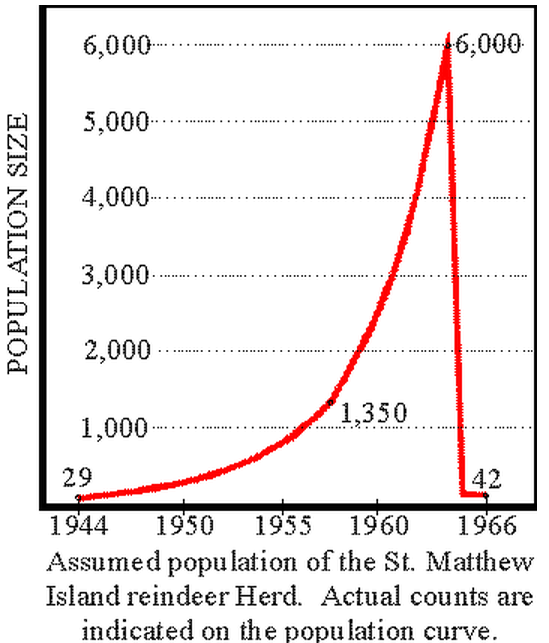There have been hundreds of books and essays written on the evolution of Homo sapiens and I assume you are familiar with that history. In this short essay I am going to point out a few things that are usually left out of that story, the part that deals with the very nature of the species Homo sapiens.
First I would like to point out a few things that are common to all species, not just Homo sapiens.
All species produce more offspring than can possibly survive to adulthood and reproductive age. Some produce hundreds of offspring and leave it to chance that a few will survive. Others produce far fewer offspring and care for them for months to years to increase their chances of survival.
However if there is ever an abundance of food for any species, that species will multiply its numbers to take advantage of that abundance until its numbers are so great that the advantage disappears. An example would be the reindeer of St Matthew Island.
In August of 1944 the Coast Guard placed 29 reindeer on St. Matthew Island, a remote island in the Bering Sea. Earlier in the year they had established a radio navigation system there and the Reindeer were supposed to be emergency rations should the men be cut off from supply shipments.
A short while later, with the allies winning the war, the Coast Guard pulled their men off the island but left the reindeer there. But not to worry, the 32-mile long by 4-mile wide island had plenty of the reindeers favorite food. A mat of lichens over 4 inches deep covered the island. By 1957 the population had increased to 1,350; and by 1963 it was 6,000. But the lichens were gone, and the next winter the herd died off. Come spring, only 41 females and one apparently dysfunctional male were left alive.
Another example was documented by the PBS series NOVA titled Rat Attack. [1] This program documents the plight of rice farmers in a remote corner of northeast India. Surrounding the rice fields in this area are forests of bamboo, a common species called Melocanna bamboo, from which the locals build their homes. And living in this tropical bamboo forest are rats. This is not unusual as rats live in all tropical forest around the world. But the rats are few enough in number that they pose no serious threat to the rice and corn farmers in the area
However once every 48 years all the bamboo flowers, fruits then dies. The Melocanna bamboo produces a fruit, a seed pod, that is as large as an apple, some 200 times larger than the average bamboo seed pod. Over the period of a few months some 10 tons per acre of this fruit will ripen and drop. This indeed brings about times of plenty for the rats in the area.
One species of rat, the black rat, is particularly adapted to take advantage of this cornucopia of food. In the right conditions their numbers will shoot up exponentially.
When the bamboo fruit first appears around this one particular rice field the black rats numbered perhaps 100. By the time all the bamboo fruit had all ripened, fell and most of it consumed by the rats, a period of about six months, the black rat population numbered about 12,000. By then any fruit left in the forest had germinated and was inedible. This hoard of rats then moved into the rice fields devouring the crops causing famine in the local population.
Then, when all the food is gone the rats die off. They die of starvation. But a few, a very few will survive.
